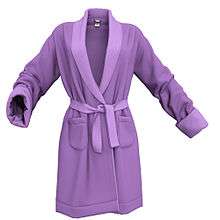Bathrobe
A bathrobe, also known as a housecoat, is a robe, a loose-fitting outer garment, worn by either men or women. Bathrobes may sometimes be worn after a body wash or around a pool.

A bathrobe is a dressing gown made from towelling or other absorbent fabric and may be donned while the wearer's body is wet, serving both as a towel and a body covering when there is no immediate need to fully dress.
Styles of fabrics
Bathrobes are generally made of four different fabrics:[1]
- Cotton: Cotton is a natural fibre consisting primarily of cellulose and is one of the most commonly used fibres in textile manufacturing. Due to the hydrophilic nature of cellulose, cotton absorbs water easily and is frequently used by the beach, pool, or following a shower. Cotton robes are especially suited to use in hot climates because cotton tends to absorb perspiration.
- Silk: Silk dressing gowns are popular because of their look and feel, but can be relatively expensive. Silk robes are very thin and lightweight, and are not particularly suited to wet situations because they lack the surface area and polarity necessary to absorb water.[2] However, silk dressing gowns are the traditional choice, since they are not worn after bathing.
- Microfiber: Microfiber is an extremely fine synthetic fiber, typically made of cellulose or polyester, that can be woven into textiles to mimic natural-fiber cloth. Modern microfibers are developed to maximize breathability and water absorption and can be thinner than the width of human hair. Much like silk, robes made out of microfiber are light in weight and are very soft to the touch. Microfiber is flammable.
- Wool: Wool bathrobes are common in colder climates.
- Nylon: Nylon is a synthetic fibre occasionally used in inexpensive dressing gowns. It is valued for its ability to be cleaned easily.
Styles of weave
Bathrobes are also categorized by their shape of weave:
- Flannel: Flannel is a soft woven fabric, made from loosely spun yarn, usually cotton or wool.
- Terry: Terry is a pile fabric, usually woven of cotton, with uncut loops on both sides, used for bath towels and robes. The longer and denser the loops are, the more absorbent the bathrobes are.
- Velour: Velour is a fabric with cut loops. Velour bathrobes are typically made with terry inside, as terrycloth absorbs water better than velour. Velour gives the bathrobe luxury, cosiness, and makes the garment softer to the touch.
- Waffle: Waffle fabric has good water absorbency, is loose and has a distinctive "gridlike" appearance. For the most part, these bathrobes are designed for their light weight.
Styles of collars
.jpg)
There are varieties of collars for bathrobes:
- Shawl collar: So called because the collar closes about the neck just like a shawl. The shawl collar is borrowed from its use on men's evening wear, the dinner jacket and smoking jacket, and is common on traditional dressing gowns.
- Kimono: This is a traditional Japanese garment and the name literally translates to ‘thing to wear’.[3] The kimono style robe actually has no collar per se.
- Hooded: A hood is sewn into the neckline, which can be worn over the head to keep it warm and help dry wet hair.
Styles of sculpture
The sculpture refers to the texture or styling of the bathrobe's fabric. The sculpture of a robe not only provides aesthetic appeal but also affects the absorbency and the hang of the item. The sculpture is a pattern sewn into the terry cloth, velour, or other fabric that reduces bulk, increases suppleness, and yields a more graceful hang on thicker styles. There are several varieties of fabric sculptures for robes:
- Window Pane: A box or checkerboard pattern in various sizes
- Zig Zag: A plush, repeating "Z" pattern
- Ribbed: A sculpture design that yields alternating vertical lines of plush material and sewn material
- Waves: Similar to the Zig Zag sculpture, but with gentler angles
Design
Each bathrobe has been differently designed with the collar and waist main features.
Most robes are fitted with a belt that ties looped through the waist to fit all sizes. A popular style is a kimono relaxed collar, as is the shawl design too, but it all depends on how you like to be covered:
- Long Bath: Terry bathrobe
- Pure: Organic robe
- Relaxed: Linen robe
- Easy Care: Lightweight bamboo robe
- Bamboo: Bamboo cotton fiber
See also
References
- "Why Terry Cotton Bathrobes?". bathrobes.net. Archived from the original on 2011-07-23.
- Articler.com, Bath Robes, archived from the original on 2007-12-17, retrieved 2007-11-12
- "Glossary". mensdressinggowns.org.
Further reading
